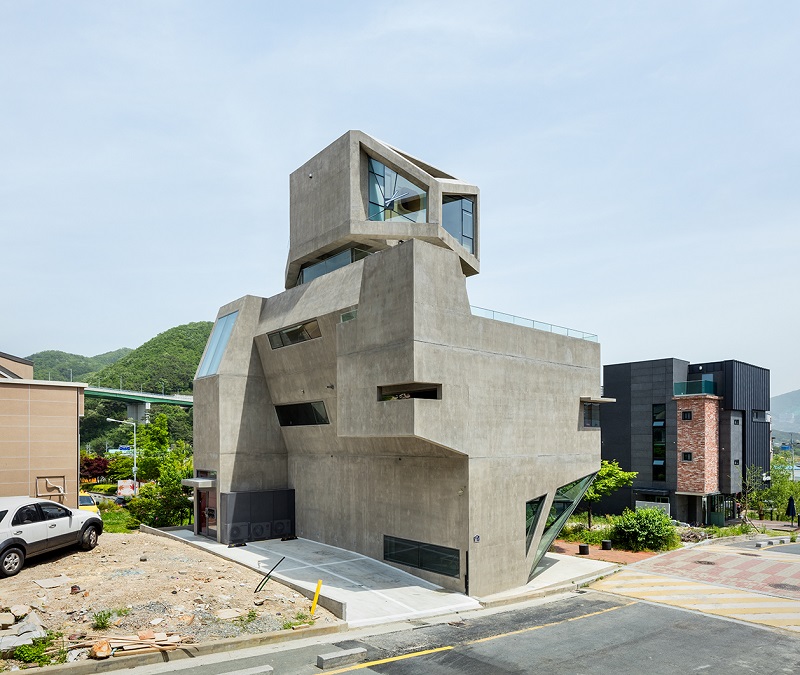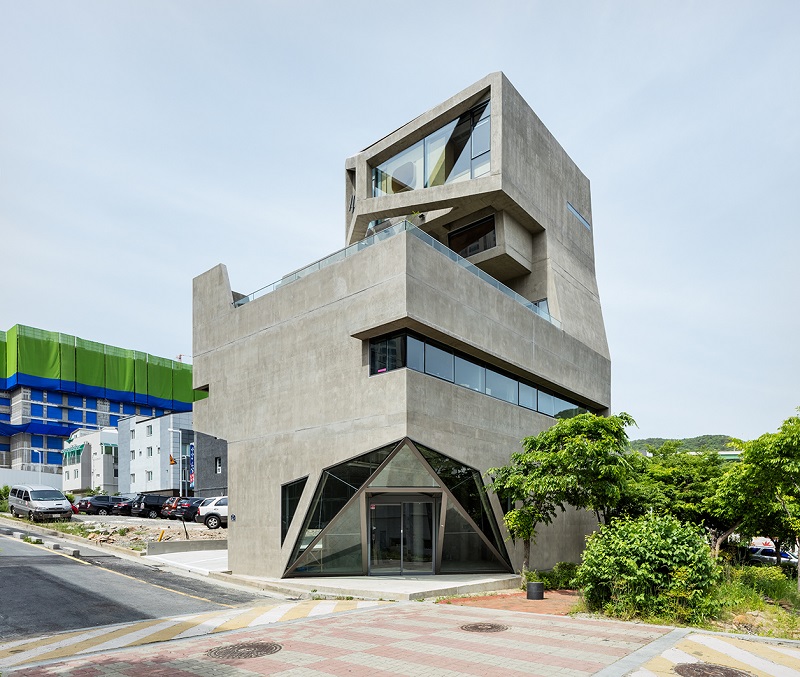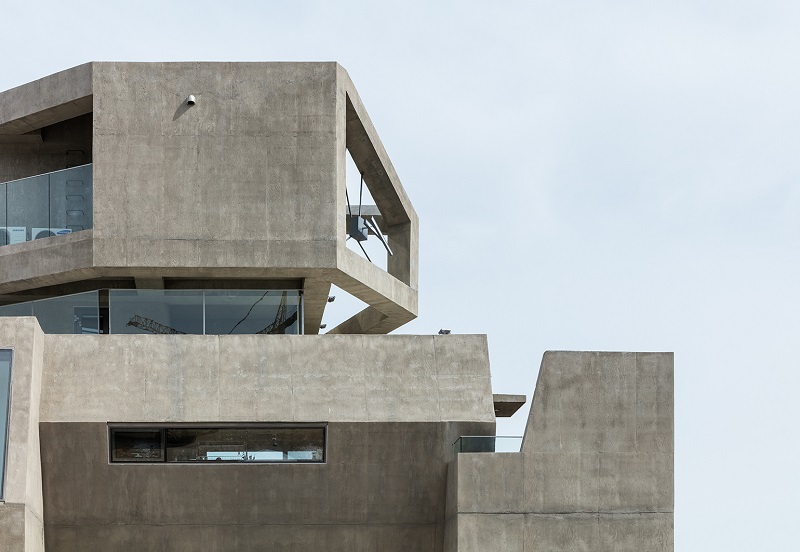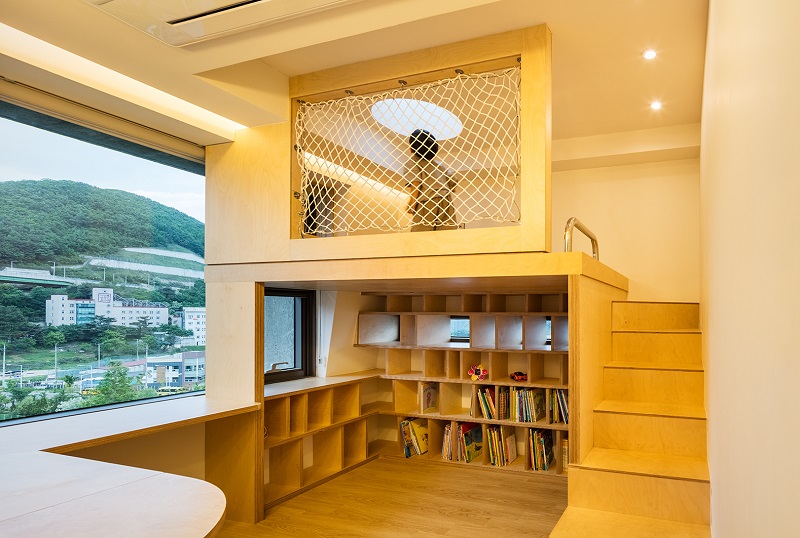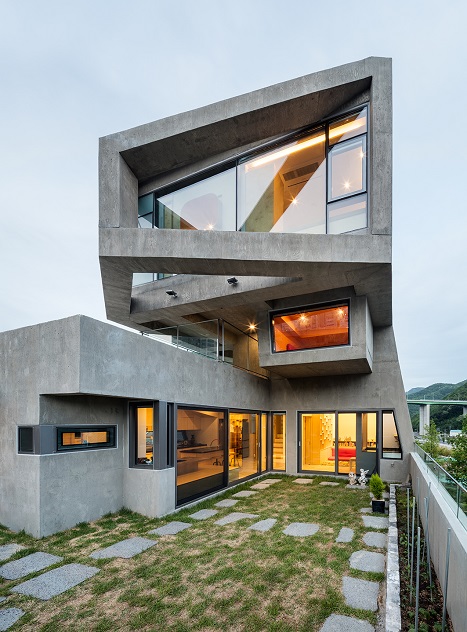Owl House, South Korea
In January 2017, the South Korean architect Moon Hoon unveiled his new housing block in the city of Busan, designed to resemble an owl.
At 16 m in height, the four-storey Busan Times building incorporates a concrete frame that extends from a large street-facing window to represent the angular face of an owl, while two openings at either sides represent eyes, which are illuminated at night.
The neck and head of the bird are represented by a series of setbacks cut into the building, creating two single-storey flats on the first floor and a smaller two-storey flat stacked above to one side. Meanwhile, a vertical block with a skylight contained within a sliced corner represents the bird’s wing, protruding from the building’s side and housing the main staircase.
Moon Hoon intended the exposed concrete building to be “full of quirks and fun” for the occupant family’s child. Their room is arranged on a split level, with a net railing protecting the mezzanine bedroom. Plenty of windows, including a small circular skylight above the bed, provide views over the city.
At the lowest level of the apartment, doors slide open onto a garden terrace established on top of a further setback. Running around the western side of the building is a ribbon of glazing, while faceted glass walls beneath create a covered entrance.
Photographs © Shin Kyungsub.
[edit] Find out more
[edit] Related articles on Designing Buildings Wiki
Featured articles and news
Architects, architecture, buildings, and inspiration in film
The close ties between makers and the movies, with our long list of suggested viewing.
SELECT three-point plan for action issued to MSPs
Call for Scottish regulation, green skills and recognition of electrotechnical industry as part of a manifesto for Scottish Parliamentary elections.
UCEM becomes the University of the Built Environment
Major milestone in its 106-year history, follows recent merger with London School of Architecture (LSE).
Professional practical experience for Architects in training
The long process to transform the nature of education and professional practical experience in the Architecture profession following recent reports.
A people-first approach to retrofit
Moving away from the destructive paradigm of fabric-first.
International Electrician Day, 10 June 2025
Celebrating the role of electrical engineers from André-Marie Amperè, today and for the future.
New guide for clients launched at Houses of Parliament
'There has never been a more important time for clients to step up and ...ask the right questions'
The impact of recycled slate tiles
Innovation across the decades.
EPC changes for existing buildings
Changes and their context as the new RdSAP methodology comes into use from 15 June.
Skills England publishes Sector skills needs assessments
Priority areas relating to the built environment highlighted and described in brief.
BSRIA HVAC Market Watch - May 2025 Edition
Heat Pump Market Outlook: Policy, Performance & Refrigerant Trends for 2025–2028.
Committing to EDI in construction with CIOB
Built Environment professional bodies deepen commitment to EDI with two new signatories: CIAT and CICES.
Government Grenfell progress report at a glance
Line by line recomendation overview, with links to more details.
An engaging and lively review of his professional life.
Sustainable heating for listed buildings
A problem that needs to be approached intelligently.
50th Golden anniversary ECA Edmundson apprentice award
Deadline for entries has been extended to Friday 27 June, so don't miss out!
CIAT at the London Festival of Architecture
Designing for Everyone: Breaking Barriers in Inclusive Architecture.
Mixed reactions to apprenticeship and skills reform 2025
A 'welcome shift' for some and a 'backwards step' for others.







